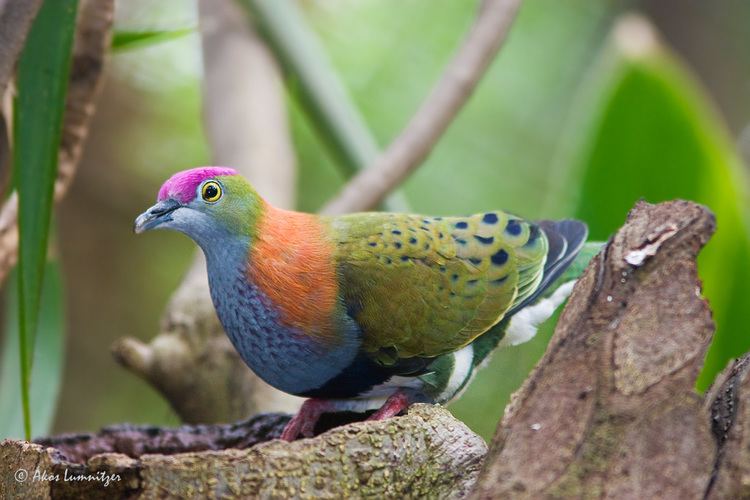Scientific name Ptilinopus | Higher classification Pigeons and doves Rank Genus | |
 | ||
Lower classifications Jambu fruit dove, Rose‑crowned fruit dove, Wompoo fruit dove, Superb fruit dove, Pink‑headed fruit dove | ||
Rose crowned fruit dove
The fruit doves, also known as fruit pigeons, are a genus (Ptilinopus) of birds in the pigeon and dove family (Columbidae). These colourful, frugivorous doves are found in forests and woodlands in Southeast Asia and Oceania. It is a large genus with about 50 species, some threatened or already extinct.
Contents
- Rose crowned fruit dove
- Fruit doves
- Description
- Distribution behaviour and habitat
- Taxonomy
- Species
- References

Fruit doves
Description

These small- to medium-sized doves generally have short, fan-shaped tails, and are remarkable for their colourful and often glossy plumage, as evidenced in the aptly named orange fruit dove, flame-breasted fruit dove, and pink-headed fruit dove. Males and females of many fruit dove species look very different. For example, the female many-coloured fruit dove shares the male’s crimson crown and deep pink undertail feathers, but is otherwise green, whereas the male has a crimson on the upper back and has areas of yellow, olive, cinnamon, and grey.
Distribution, behaviour, and habitat

This is a large genus, most diverse in and around the island of New Guinea, in the Philippines, and in the biogeographical region of Wallacea. Some species have ranges as far west as the Sunda Islands, others north to Taiwan, south to Australia, and east into Polynesia.
Fruit doves, as their name implies, eat fruit—ficus is especially important—and live in various kinds of forest or woodland. Some species are restricted to primary forest, such as lowland rainforest, montane forest, or monsoon forest, while others prefer secondary forest or disturbed areas. Some species specialize in particular habitats, from lowland coastal forest to the cloud forest or moss forest of high altitudes. Some species of fruit doves are only found in habitats dominated by particular plants, such as mangrove, eucalyptus, or pandanus. Only a few species can commonly be seen around human habitation, these include the knob-billed fruit dove, Makatea fruit dove, and black-naped fruit dove, which are known to visit gardens and such.
Much is still to be learned about fruit doves. Many species are shy and difficult to observe in their natural habitat. For example, there are several species in the Philippines, and for most of them, little or nothing is known of their breeding or nesting behavior.
Taxonomy
The many species of this genus can be further grouped by geography and by certain shared characteristics. The fruit doves of the Sunda Islands and northern Australia, such as the pink-headed fruit dove and banded fruit dove, have comparatively longer tails than other species, and are notable for their solid colouration on the head, neck and breast, with a black band across the belly. Another grouping can be made of certain fruit doves endemic to New Guinea, the Moluccas, and the Bismarck Archipelago, including the carunculated fruit dove, knob-billed fruit dove, and others; these are notable for their grey colouration on the head or shoulder and/or enlarged cere (part of the bill). This group is uncharacteristically not sexually dimorphic, meaning males and females look alike. The orange dove, golden dove, and whistling dove, all endemic to Fiji and sometimes placed in their own genus Chrysoenas, have in common their small size, compact shape, yellow or orange colouration in the males, and hair-like body feathers. They also are known for their rather un-pigeon-like vocalizations, which sound like snapping, barking, or whistling, respectively. Finally, the Pacific Islands provide homes to a number of species that share generally green colouration with crimson caps or crowns, ventriloquial cooing or hooting, and a distinct texture of the breast feathers. The grey-green fruit dove is typical of this group. Recent evidence suggests Ptilinopus as presently defined is paraphyletic as Alectroenas and Drepanoptila are embedded within it. The generic name Ptilinopus comes from the Ancient Greek words ptilon "feather," and pous, "foot."
